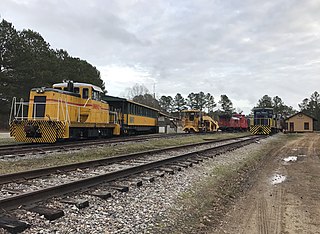
Baldwin Locomotive Works (BLW) was an American manufacturer of railway locomotives from 1825 to 1951. Originally located in Philadelphia, Pennsylvania, it moved to nearby Eddystone in the early 20th century. The company was for decades the world's largest producer of steam locomotives, but struggled to compete when demand switched to diesel locomotives. Baldwin produced the last of its 70,000-plus locomotives in 1951, before merging with the Lima-Hamilton Corporation on September 11, 1951, to form the Baldwin-Lima-Hamilton Corporation.
The Lehigh Valley Railroad was a railroad in the Northeastern United States built predominantly to haul anthracite coal from the Coal Region in Northeastern Pennsylvania to major consumer markets in Philadelphia, New York City, and elsewhere.

The Reading Company was a Philadelphia-headquartered railroad that provided passenger and freight transport in eastern Pennsylvania and neighboring states from 1924 until its acquisition by Conrail in 1976.

This is a list of the earliest railroads in North America, including various railroad-like precursors to the general modern form of a company or government agency operating locomotive-drawn trains on metal tracks.

The Main Line of Public Works was a package of legislation passed by the Commonwealth of Pennsylvania in 1826 to establish a means of transporting freight between Philadelphia and Pittsburgh. It funded the construction of various long-proposed canal and road projects, mostly in southern Pennsylvania, that became a canal system and later added railroads. Built between 1826 and 1834, it established the Pennsylvania Canal System and the Allegheny Portage Railroad.
The Lehigh and New England Railroad was a Class I railroad located in Northeastern United States that acted as a bridge line. It was the second notable U.S. railroad to file for abandonment in its entirety after the New York, Ontario and Western Railway. It was headquartered in Philadelphia.

Edaville Railroad is a heritage railroad and amusement park in South Carver, Massachusetts, opened in 1947, and temporally closed during the COVID-19 pandemic in 2020. The park was only open for the Christmastime season in 2021, and will reopen under new management for the 2022 Christmastime season. It is one of the oldest heritage railroad operations in the United States. It is a 2 ft narrow gauge line that operates excursion trains for tourists, built by the late Ellis D. Atwood on his sprawling cranberry farm in Southeastern Massachusetts.

The Lahaina, Kaanapali and Pacific Railroad (LKPRR) was a steam-powered, 3 ft narrow gauge heritage railroad in Lāhainā, Hawaii. The LKPRR operated the Sugar Cane Train, a 6-mile (9.7 km), 40-minute trip in open-air coaches pulled by vintage steam locomotives. The tracks connected Lahaina with Puukolii, stopping briefly at Kaanapali. A narrator pointed outs sites of interest during the trip, which crosses a 325-foot (99 m) curved wooden trestle whose elevation yields panoramic views of neighboring islands and the West Maui Mountains. The line is currently not operating and all equipment is stored north of Lahaina.

The Black Hills Central Railroad is a heritage railroad that operates in Keystone, South Dakota, United States. The railroad was added to the National Register of Historic Places on February 5, 2003.

The Arcata and Mad River Railroad, founded in 1854, was the oldest working railroad in California. It operated on a unique narrow gauge until the 1940s when standard gauge rails were laid. Service ceased in 1983 due to landslides. It is California Historical Landmark #842.
Railroad electrification in the United States began at the turn of the 20th century and comprised many different systems in many different geographical areas, few of which were connected. Despite this situation, these systems shared a small number of common reasons for electrification.

The New Hope Valley Railway is a heritage railroad in Bonsal, North Carolina operated by the North Carolina Railway Museum, Inc., an all-volunteer, nonprofit, and tax exempt educational and historical organization.

The Reading Blue Mountain and Northern Railroad, sometimes shortened to Reading and Northern Railroad, is a regional railroad in eastern Pennsylvania. Its headquarters is in Port Clinton. The RBMN provides freight service on 400 miles (640 km) of track. Its mainline consists of the Reading Division between Reading and Packerton and the Lehigh Division between Lehighton and Dupont. Its main freight cargo is anthracite coal.
The Heart of Dixie Railroad Museum is the official state railroad museum of Alabama. Dedicated to the preservation, restoration, and operation of historically significant railway equipment, the museum is located at 1919 Ninth Street, Calera, Alabama, on I-65 approximately 30 miles (48 km) south of Birmingham.

The Schuylkill Branch was a rail line owned and operated by the former Pennsylvania Railroad (PRR) in Pennsylvania. The line ran from the Philadelphia to Harrisburg Main Line at 52nd Street in Philadelphia north via Norristown, Reading, and Pottsville to Delano Junction, about 2.5 mi (4.0 km) northeast of Delano. From Delano Junction, the PRR had trackage rights over the Lehigh Valley Railroad's Hazleton Branch and Tomhicken Branch to Tomhicken, where the PRR's Catawissa Branch began.

Wanamaker is small community in Lehigh County, Pennsylvania. It is part of the Lehigh Valley metropolitan area, which had a population of 861,899 and was the 68th most populous metropolitan area in the U.S. as of the 2020 census.

The Nesquehoning Valley Railroad Company, herein called the Nesquehoning Valley Railroad (NVRR), is now a fallen flag standard-gauge, steam era shortline railroad built as a coal road to ship the Anthracite mined in the Southeastern Coal Region on either side of the Little Schuylkill River tributary Panther Creek and the history making coal towns of the Panther Creek Valley down the Lehigh River transportation corridor to the Eastern seaboard.


















